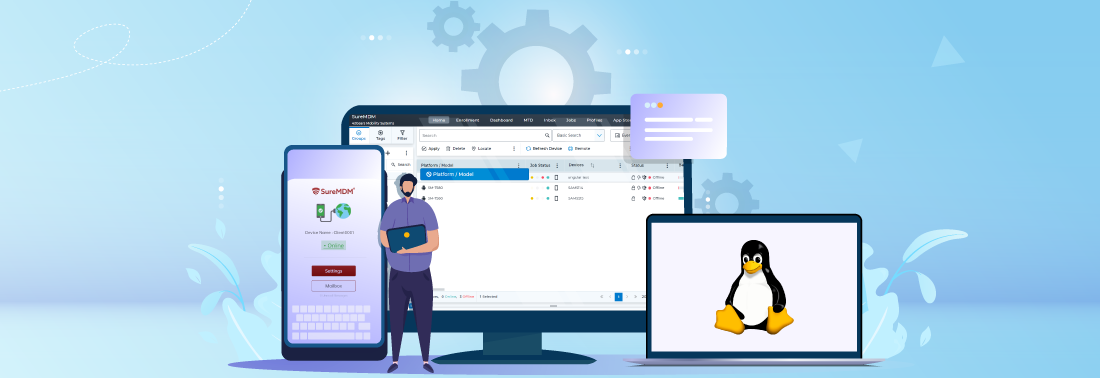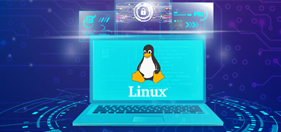How to Choose the Right Linux Device Management Software?
Feb 07, 2023 | 42Gears Team
Linux is one of the most widely used operating systems across the globe. Because of how simple it is to install and use, it is widely accepted as a viable alternative to traditional operating systems and is used in a wide range of applications. However, IT teams continue to struggle to gain full visibility into available Linux devices and their applications. They strive to maintain compliance, protect data and networks against malware attacks, and deploy consistent automated patching processes for Linux endpoints. This is because obtaining data from Linux devices deployed across geographies is difficult. That’s where a Linux device management platform can help.
A Linux device management platform is used by IT admins to onboard, monitor, provision, and secure Linux devices. With Linux device management software, IT admins can take the device management process to the next level by gaining granular control of each device. They can get all the necessary information about every Linux device in one go. The platform allows IT admins to perform actions, such as pushing updates, rebooting, shutting down devices, and wiping data, straight from the dashboard. By enabling kiosk mode on Linux devices, IT admins can restrict user access to only a few applications. This helps in ensuring security and avoiding misuse of devices for non-business tasks.
Now that we have understood what Linux device management software is and why businesses need such a tool, let’s take a look at some of its important features:
- IT admins can drive bulk device enrollment with multiple methods and make device provisioning quick and easy.
- They can provide round-the-clock support for the remote workforce and troubleshoot device issues remotely. By instantly fixing device issues, software errors, network errors, and glitches, IT admins can improve employee productivity, reduce downtime, and save costs and time spent on in-person troubleshooting.
- IT admins can run Linux scripts to perform any operation on Linux devices installed in remote locations.
All these features and capabilities make Linux device management software a preferred choice for IT teams to manage their fleet of Linux devices.
But, an important question that troubles most of the CIOs and CTOs is “How do we choose the right Linux device management software?”
With so many Linux device management platforms to choose from, it can be hard to pick the right one. To help C-level executives and IT admins, we have listed some of the important aspects that they must consider while choosing the best Linux device management software.
Key Features That Every Linux Device Management Solution Must Have!
Find out more about Linux device management solutions and their desirable features.
Unified Web Console
When an organization has numerous Linux devices, monitoring all the devices and the applications on them can be challenging, particularly when teams are working remotely. A good Linux device management solution should have a feature to manage all the distributed Linux devices from a single centralized console. The platform should help IT admins configure, provision, monitor, and decommission (when needed) devices. It also allows them to install, uninstall, and update apps.
Support Different Devices and Applications
The last thing you want from a newly purchased platform is compatibility issues. An ideal Linux device management solution is one that supports all major Linux distributions, including CentOS, SUSE, Linux Mint, Ubuntu, Fedora, and Red Hat Enterprise Linux.
Defend Cyberattacks
In today’s digital world, security is paramount for any organization. Every business is under constant threat from a wide range of cyberattacks. Make sure the Linux device management software you choose offers strong security controls. A platform with useful features, such as device lockdown, access control, and wipe, can prove instrumental in preventing cyberattacks.
Remote Linux Desktop Tool
Hybrid and remote work models are here to stay. With employees logging in remotely from multiple locations, it is impossible for IT admins to physically visit different sites and troubleshoot every Linux device that does not function as intended. Therefore, every enterprise requires a Linux device management tool that allows for remote troubleshooting.
OS Update
Software updates are essential to keep devices running smoothly and reduce security vulnerabilities. While zeroing in on a Linux MDM solution, make sure the platform allows you to install kernel and OS updates remotely.
Remote Linux Shell Scripting and System Configuration
Shell scripts are mostly used to automate repetitive and time-consuming tasks that require line-by-line execution. The Linux device management platform that you choose should be able to remotely execute Linux shell commands and distribute resources with just a click. It should also assist you in remotely changing Wi-Fi settings, blocking USB, and changing other system configurations.
User Management
A dynamic Linux device management solution will allow you to easily add, remove, and manage users on Linux-based devices. It is an added advantage if the Linux device management software also allows you to modify admin-access.
Managing Linux Devices Using 42Gears SureMDM
42Gears’ SureMDM helps admins solve major concerns related to managing, monitoring, and securing all the Linux devices within a network. SureMDM helps admins increase their efficiency by letting them automate all device management tasks from a single console.
SureMDM features a centralized web console, which helps IT admins install applications or push software updates on multiple Linux devices at once. All the Linux devices can be brought under one roof to enable seamless management. To keep Linux devices safe and secure, IT admins can turn Linux devices into dedicated kiosks. This enables IT admins to restrict access to specific applications. They can also block, approve, or disapprove specific websites. This feature ensures users are not distracted and the security of corporate data is not compromised.
You can use SureMDM to install kernel and OS updates remotely. OS patches can be pushed to all Linux devices at once, ensuring they all receive the latest security updates. With just one click, you can remotely distribute files, media, and documents to a large number of devices using the Linux device management platform. Executing remote shell scripts is even easier through SureMDM. You can execute Linux shell commands to perform any operation on a remote Linux device.
Overall, 42Gears’ SureMDM makes it extremely easy to manage Linux devices and endpoints and to perform day-to-day device management tasks.
Deploy SureMDM to manage your
Linux devices.
Subscribe for our free newsletter








